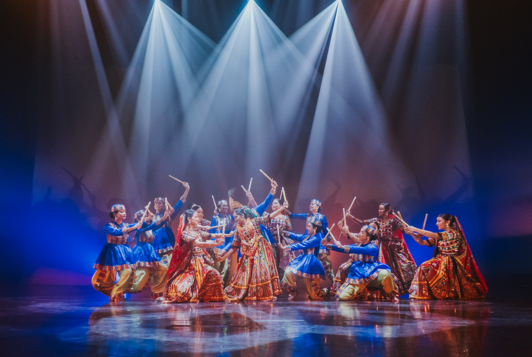An enthusiastic crowd of 6,700 audience members attended the annual NUS Arts Festival 2023 themed Spaces Between, which featured over 20 live performances, films, public art, installations and dialogues. Taking place across three weekends in March, the festival was the largest performing arts event on campus.
The lifting of pandemic restrictions allowed for greater room for creativity and experimentation, as more performers could be fielded, and different venues could be explored to offer a variety of viewing experiences. Nearly 800 NUS students, alumni, faculty, staff and collaborators took part in the festival, nearly twice of 2022 figures.
Exploration of intimate liminal spaces, an ode to the Festival theme

MOONRISE, an immersive multi-sensorial musical experience took place in the unconventional University Cultural Centre (UCC) Atrium. Led by YST Conservatory alumna Churen Li, who goes by the stage name CHUREN, the visually stunning show presented a first-time collaboration with soundscape artist/music producer evanturetime and digital effects artist Prako. It featured CHUREN’s modern interpretations of classics such as Clair de Lune and Moonlight Sonata amidst found sounds and subtly beat-driven soundscapes, complete with digital visual design.
“We explored the liminal space between three different artistic praxes: classical piano, music production and video art. We want to transcend the boundaries of our individual disciplines and build synergy between the realms of sound and vision. The ideal space for this project would not be in a conventional arts space, but rather in the UCC Atrium, to create the unexpectedness of walking into an artistic world that the audience member would not expect,” CHUREN said.

Also taking place in a liminal space is the one-woman play, The Future Show, headlined by NUS Law alumna Jo Tan. It is the first Singaporean version of the internationally performed concept by Canadian playwright Deborah Pearson. Marketed as a secret location, The Future Show, took place within the frills-free CFA Studios, and welcomed only a maximum of 40 audiences per show time, making it the most intimate production within the festival. The venue was chosen in part, due to Ms Tan’s personal affinity to the space as a former student artist and resident of the neighbouring Raffles Hall.
The venue was effective as a companion to Ms Tan’s intense and visceral performance of her imagined life in the near and distant future, one of hope, insecurities and mortality. It had also inspired her to visit other spaces within the NUS campus to write her material for the show.
“The play has allowed me to reconnect quite personally with my alma mater NUS, as I find myself revisiting different areas of the campus so as to best predict the different possible thoughts and happenings that would arise after someone leaves our performance space and passes through the university grounds,” she said.

Also taking place in an unconventional space was OmnIVerse: The Fourth Dimension, an electronic music showcase by NUS Electronic Music Lab, which featured 15 original music tracks in chillwave, synthwave and darksynth. It took place in the lesser-known UCC Dance Studios, located along an alleyway on Level 2. Finding the space required the help of festival volunteers, and a blue lighted path that was intentionally-designed.
Ho Jia Wei, President of NUS Electronic Music Lab and second-year NUS Computing student, supported the choice of the space. “This year’s performance was unique as it was not a regular sit-down show where the audience will be stationary. Instead, they were able to move around during the performance and experience how space and music can interact with each other to create a sense of liminality,” he said.
Refreshing collaborations and discoveries from the pushing of creative boundaries
End of the Line, a jukebox musical on the struggles of youth exacerbated by cyberbullying and peer pressure, stretched the abilities of the NUS Stage actors. It also brought to light the songwriting abilities of some of its talented cast which included the NUS Stage Vice President, Lim Jia Ying, a second-year NUS Science student.
“In the other NUS Stage performances I’ve been involved in, they were very naturalistic and focused on acting. End of the Line was a collaboratively devised piece that weaved our personal life stories and experiences into a story that highlighted what was important to our generation. It also incorporated live singing, lip-syncing, and dancing, as well as acting. This also marked my first foray into lyric-writing and composition,” Jia Ying said.

Beyond the artistry, the NUS Arts Festival also provided the opportunity to imbue character-building and learning moments that endure long after the curtain call.
Abirami Senthil Kumar, second-year Environmental Engineering student, and President of NUS Indian Dance, who performed in kSAnti - Patiently Waiting, had this to share.
“kSAnti - Patiently Waiting has helped me reflect on all the areas in life that we knowingly or unknowingly wait, and to be patient. It has been such a special experience to see all dancers apply all their reflections and gain more insights as they get deeper into the topic of Spaces Between.”
Share:
Contributor
Writer: Janice Low, Office of Student Affairs
This article was first published on NUS News.



